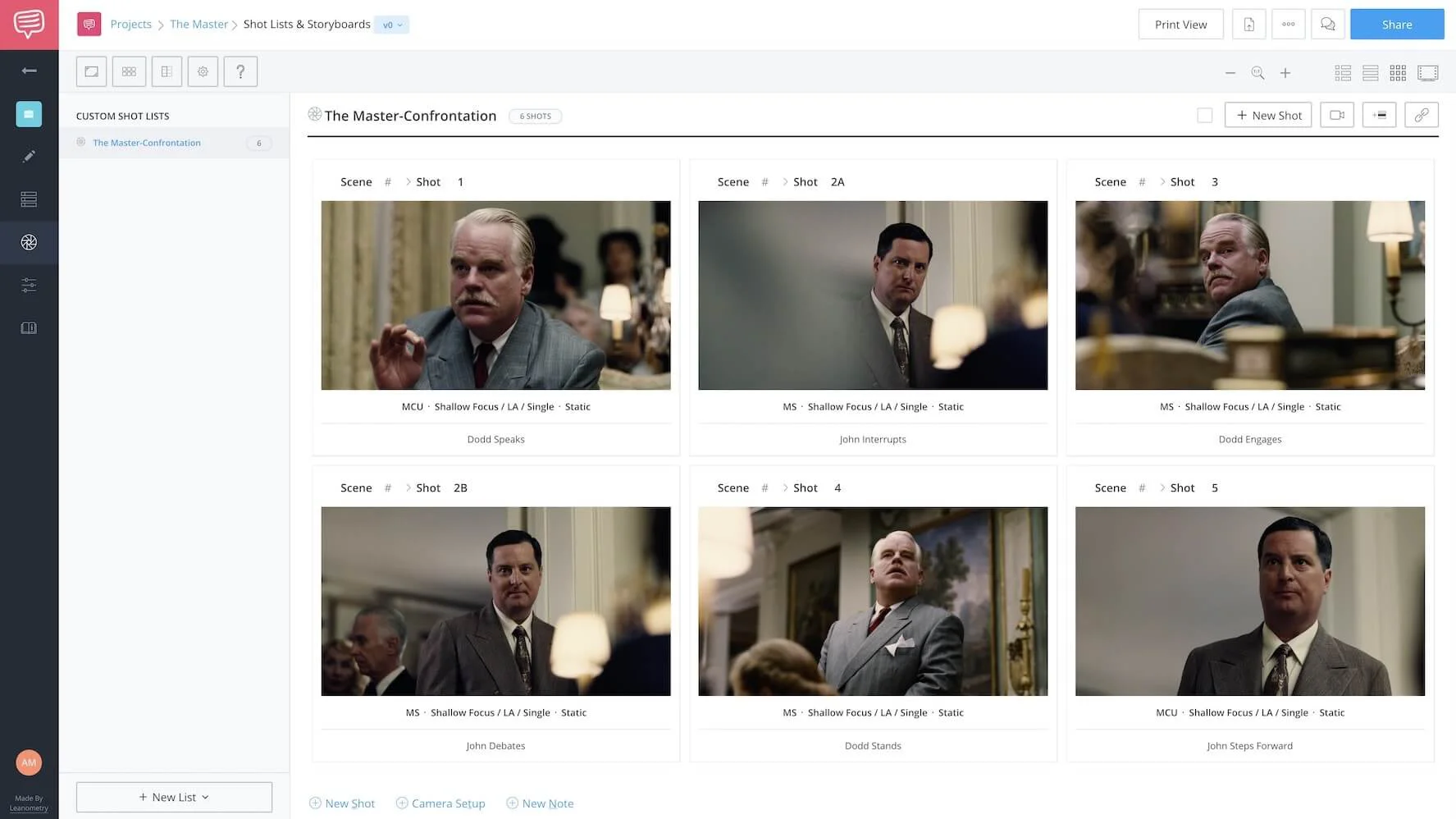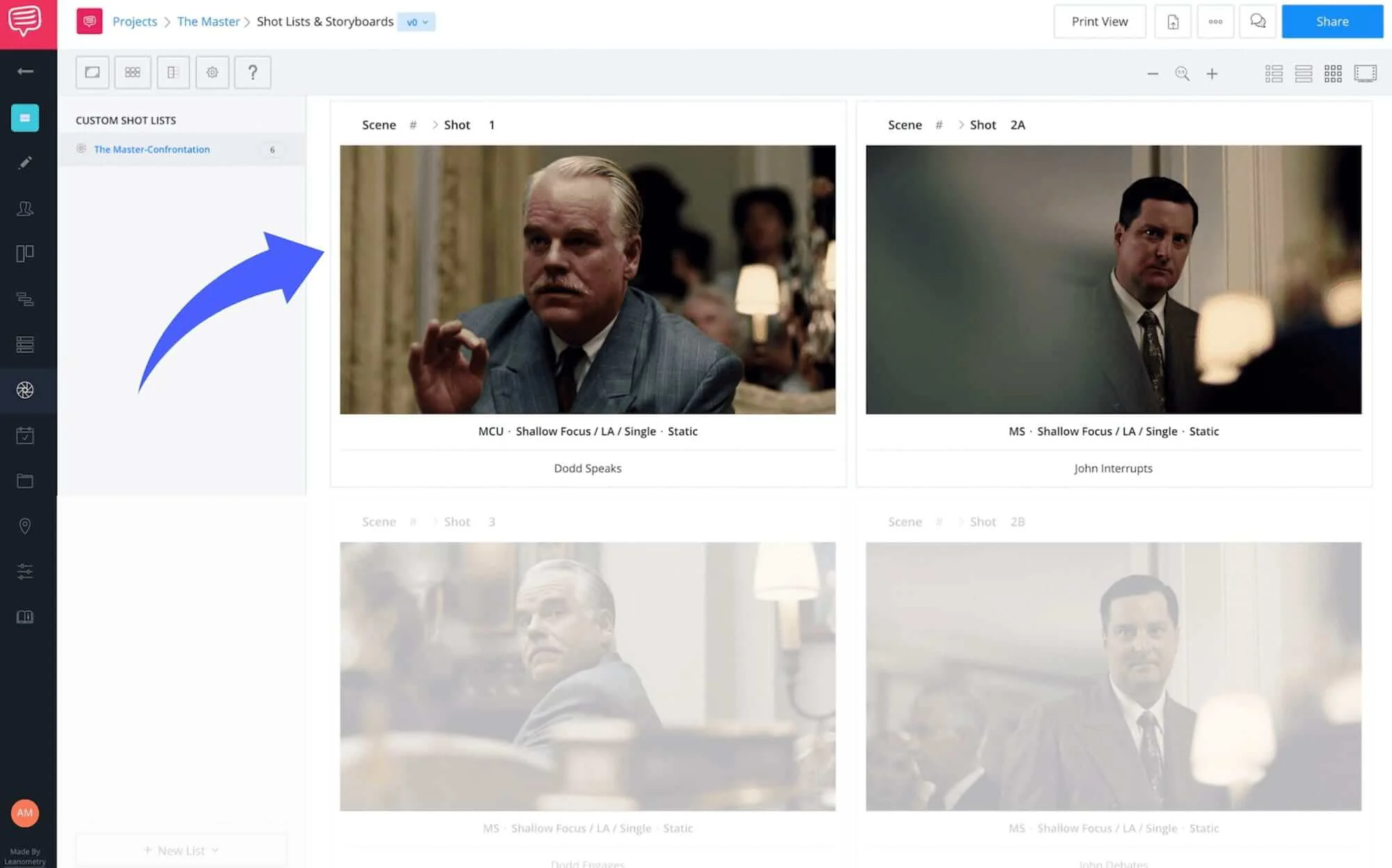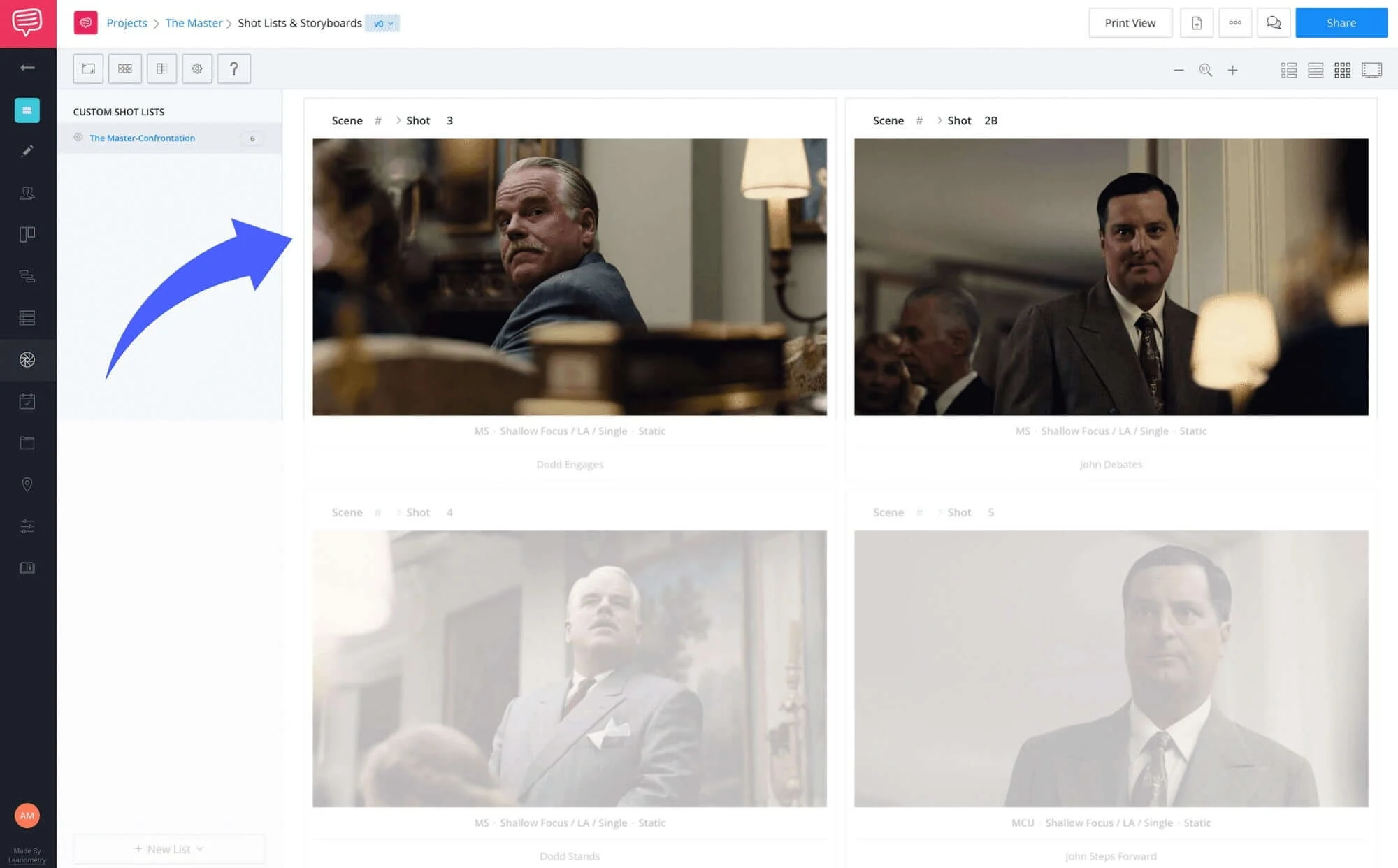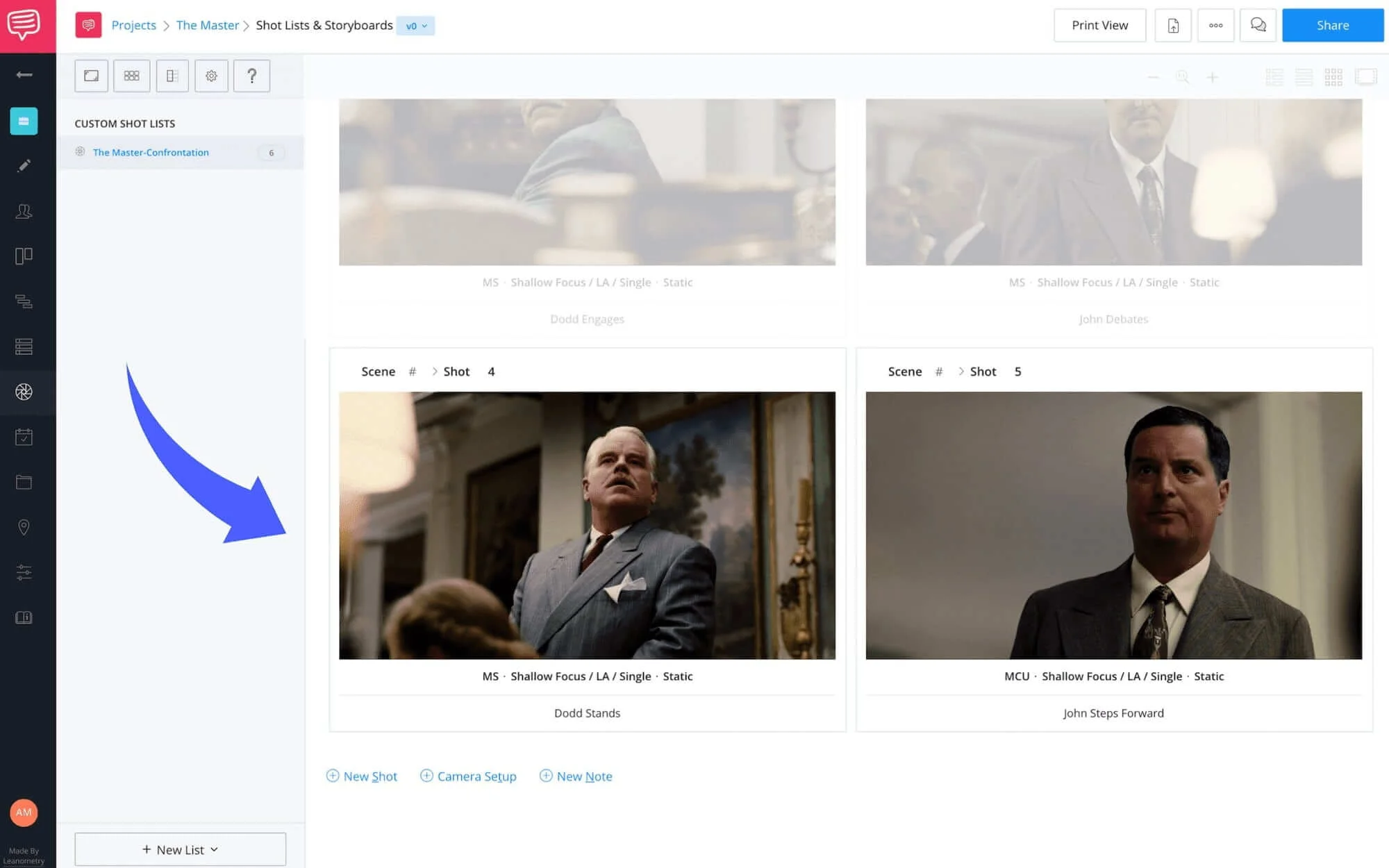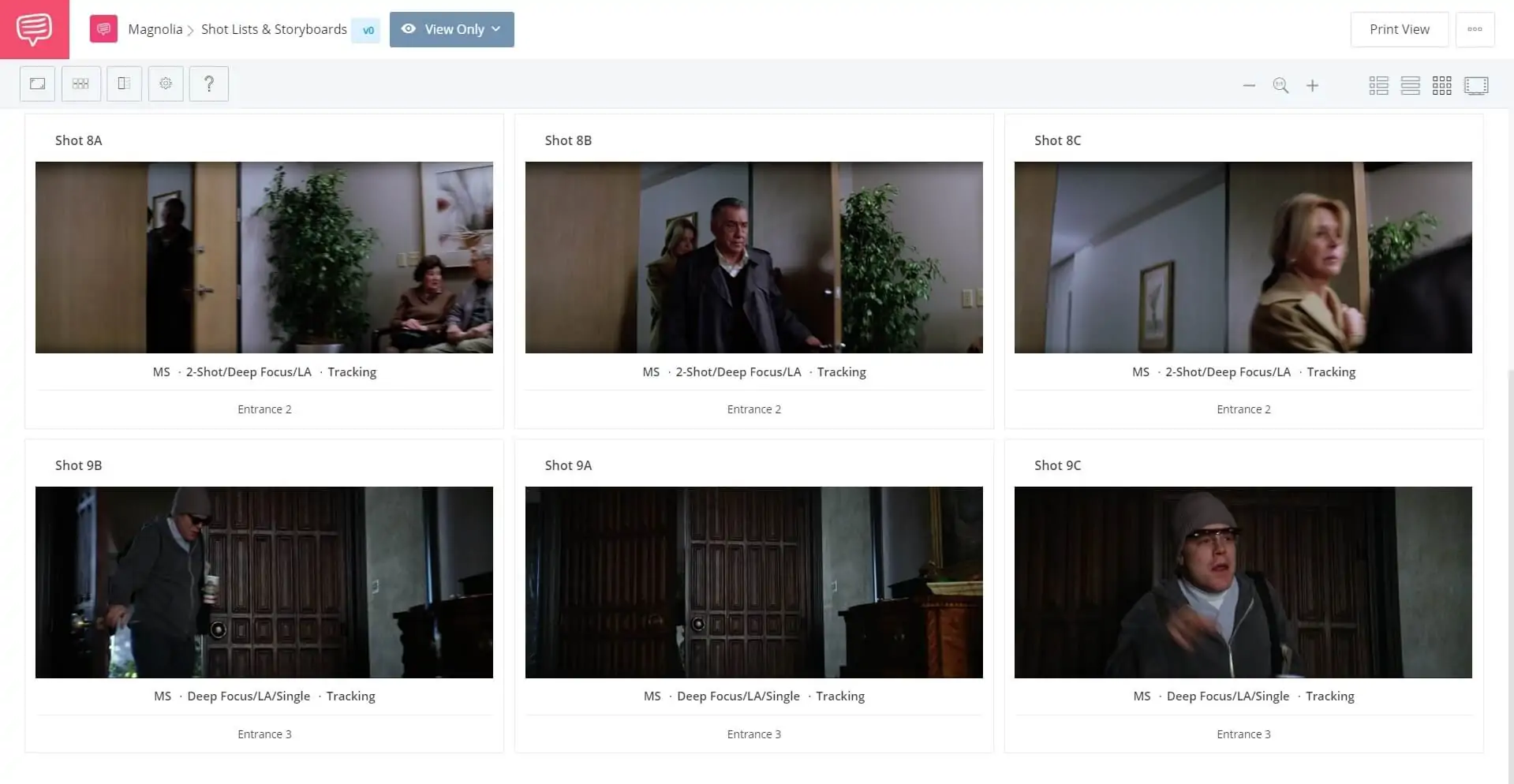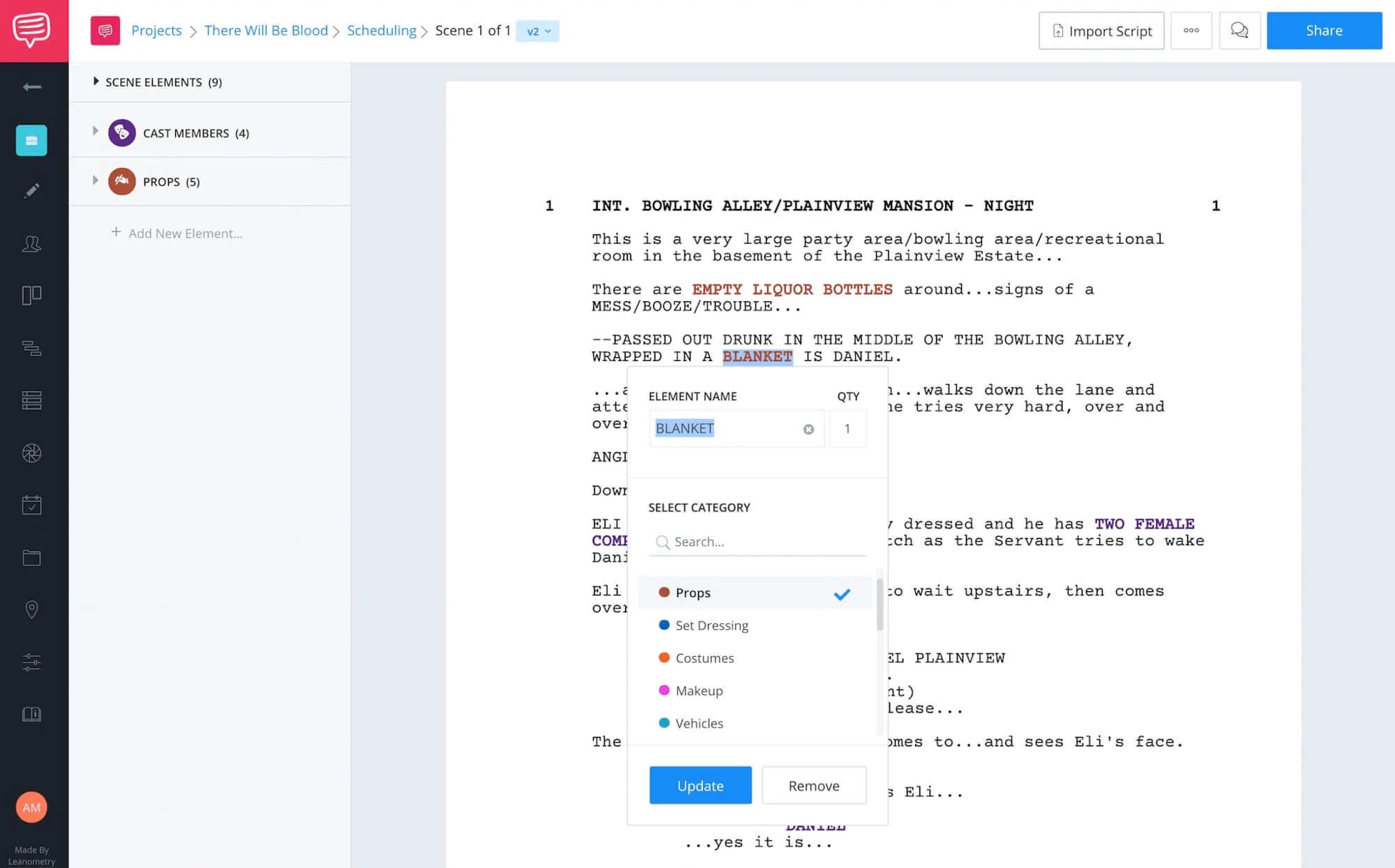Paul Thomas Anderson movies have evolved over the last two decades. His early films are chaotic and dramatic, built with extreme techniques and extreme performances. His later films have similar intensity, but it is often internal, more intellectual than physical. And his directing style has also become more mature and restrained.
So far, P.T. Anderson only has eight feature films under his belt, but he has emerged as one of the most exciting American filmmakers. Let’s take a trip through his filmography and find out what makes Paul Thomas Anderson movies so damn good.
The Directing Style of Paul Thomas Anderson
Table of Contents
The Ultimate Guide to Paul Thomas Anderson
1
Paul Thomas Anderson Movies
A Filmography From the Heart
Paul Thomas Anderson Films
The complete list of PTA movies
In another post, we have Paul Thomas Anderson movies ranked but they’re all fantastic. Of course, people have their favorites but, so far, there isn’t such a thing as a bad Paul Thomas Anderson movie.
Hard Eight (a.k.a Sydney) (1996)
Professional gambler Sydney teaches John the tricks of the trade. John does well until he falls for cocktail waitress Clementine.
Paul Thomas Anderson Movies: Hard Eight
Boogie Nights (1997)
The story of a young man's adventures in the California pornography industry of the late 1970s and early 1980s.
Paul Thomas Anderson Movies: Boogie Nights
Magnolia (1999)
An epic mosaic of interrelated characters in search of love, forgiveness, and meaning in the San Fernando Valley.
PTA Movies: Magnolia
Punch-Drunk Love (2002)
A psychologically troubled novelty supplier is nudged towards a romance with an English woman, all the while being extorted by a phone-sex line run by a crooked mattress salesman, and purchasing stunning amounts of pudding.
Crafting a Cinematic Moment • Subscribe on YouTube
There Will Be Blood (2007)
A story of family, religion, hatred, oil and madness, focusing on a turn-of-the-century prospector in the early days of the business.
Paul Thomas Anderson Movies • Subscribe on YouTube
The Master (2012)
A Naval veteran arrives home from war unsettled and uncertain of his future - until he is tantalized by The Cause and its charismatic leader.
A scene from The Master
Inherent Vice (2014)
In 1970, drug-fueled Los Angeles private investigator Larry "Doc" Sportello investigates the disappearance of a former girlfriend.
Doc and Bigfoot, Inherent Vice
Phantom Thread (2017)
Set in 1950s London, Reynolds Woodcock is a renowned dressmaker whose fastidious life is disrupted by a young, strong-willed woman, Alma, who becomes his muse and lover.
Phantom Thread
Now for the fun part. Let's jump into the brilliance of Paul Thomas Anderson.
Auteur Theory Made Practical
Explore directing techniques used by the greats
Create works like these iconic auteur directors. Explore practical directing tips you can immediately put into action on your next project
EXPLORE Auteur Directors
2
Cinematography Techniques
PTA'S CAMERA AND COMPOSITION
Iconic Moments in Punch-Drunk Love
Crafting memorable moments
There are many iconic moments in P.T. Anderson movies. He achieves this with larger than life characters matched and his virtuoso filmmaking techniques. Using elements like narrative contrast, shot composition and lighting, Anderson accents this moment of awkward but earnest love.
If you’re interested in P.T. Anderson’s directing style, chances are you’ll want to read our post on the greatest auteurs of all time.RELATED POSTS
Shot Composition in The Master
Framing power and vulnerability
The Master is P.T. Anderson's most beautifully shot film. He shot it in 65mm, which allows for richness and sharpness in the image.
The Master is about power, belief, and how those two themes intersect. The faith of his followers empowers Lancaster Dodd (Philip Seymour Hoffman), who is rarely questioned or doubted. But that changes in this scene.
We created a shot list for this interaction using StudioBinder's shot listing software. You can see for yourself how the camera framing and shot composition between the two character match their level of authority.
As Dodd is explaining the idea of past trauma, he is interrupted by another guest named John More (Christopher Evan Welch). John questions Dodd's teachings in front of the other guests. And it gets uncomfortable real quick.
At this moment, Dodd's power is threatened. He is vulnerable in a way we have yet to see him. And the shot compositions signal this vulnerability.
When Dodd is speaking, we first see him in a medium close-up, centered in the frame. He is holding court and the singular focus of everyone in the room.
Our first shot of John is a medium shot, and he is partially obscured. He is blocked visually by Dodd and his wife, Peggy (Amy Adams). He is a background character of very little importance.
We see him in this frame four times, as he continues to interrupt. And it is not until Dodd finally engages that John’s frame opens up. Now that their confrontation has begun, the power of switches from Dodd to John. And we get two new set-ups to mark this transition.
Dodd is framed in a medium shot from behind. He has to turn to look behind himself at John, and he is now partially obscured by foreground props. It is an awkward position, and his disadvantage is obvious. In the reverse angle, John is no longer obscured as his presence in the room becomes official.
Dodd shrinks between his first two shots, but John grows larger as does the threat he represents. Then, Dodd stands up to face his accuser, finally. No longer sitting with his back to John, Dodd's new position is an attempt to regain his authority.
In the very next shot, John steps forward into a tighter medium close-up. He is now larger in the frame and unobscured by anyone or anything.
Dodd's authority is threatened by someone who began the scene as an inconsequential, anonymous guest. They end the scene with John having gotten the upper hand. And this transition is expertly reinforced by simple frame composition choices.
On paper, this scene is a heated conversation between two people. As written, you might not be able to sense the shift in power. On screen, we see the change, and the scene takes on new meaning.
There are always strategies to make your scenes more interesting. When you film a confrontation like this, keep these concepts in mind.
Related Posts
Camera Movement in Boogie Nights
Show us their world
In Boogie Nights, like many PTA movies, the camera is continuously moving. The lifestyle of these porn actors and actresses is chaotic and intense. The frenetic camera emphasizes the chaos and brings us closer to what that life feels like.
There is no shortage of great camera movement in Boogie Nights. When you think you've seen the coolest shot ever, Anderson stuns you all over again. Let's take a closer look at a shot that is less flashy but does wonders to establish our lead character, Eddie.
After the glitz and glam of the nightclub scenes, Eddie (Mark Wahlberg) returns home. In this shot, Eddie walks into his room and gets undressed. As he does, the camera does a 360-degree camera pan of the bedroom.
Meet Eddie Adams
What's the point of this shot? What purpose does it serve?
This shot gives us a proper introduction to our main character. We learn everything we need to know about this character. Eddie's life is on his walls.
He's a musician, he loves fast cars and beautiful women, and he's a massive fan of Bruce Lee. Every one of these things is waiting for him if he agrees to start making adult movies with Jack (Burt Reynolds). He'll get the car, he'll get the women, and he'll be the next kick-ass action star.
It's not simple foreshadowing; it is character development. In one shot, we can see that Eddie has been waiting for this opportunity. Some characters don't know what they want in Act One. Others, like Eddie, absolutely do.
So, when he goes for it, that character decision is already motivated. But this shot isn't significant for the set decoration alone. The posters on the wall show us Eddie's interests, but the camera shows us much more.
Eddie's world is small. The circular motion of the 360 pan shows us the limits of that world. It is claustrophobic and finite. The decision to become an actor will be the prison break he's been looking for.
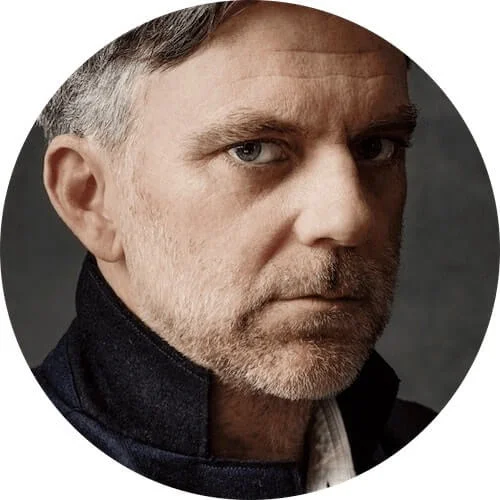
“I’m completely aware of the fact that I am a control freak.”
— Paul Thomas Anderson
This is an excellent example of economical storytelling. It gives the audience valuable information as efficiently as possible. Look how much story and character we get from meaningful set decoration and a simple camera move.
How much can we learn about your main character in a single shot? How can you tell us who they are and what they want without a word of dialogue?
3
Editing Techniques
Suspenseful Editing
Suspense in Hard Eight
Edit for suspense and character
Editing suspense is pretty straight forward. By manipulating time and delaying the inevitable, we get suspense. But what if you could edit for suspense and character at the same time? This is precisely what P.T. Anderson did in his first film, Hard Eight.
At the climax of the film, Sydney (Philip Baker Hall) has made a crucial decision to kill Jimmy (Samuel L. Jackson). Sydney breaks into Jimmy's house, finds his guns, and waits for Jimmy to come home.
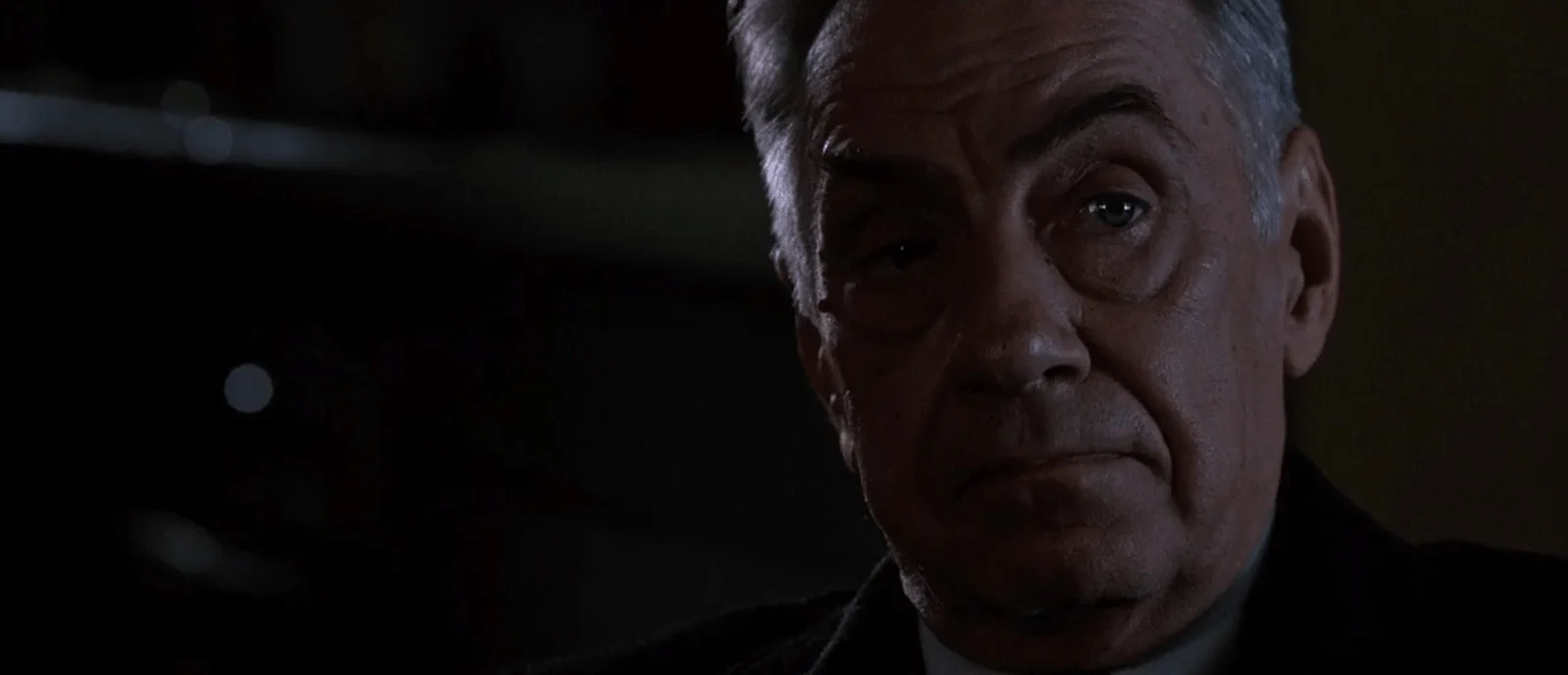
Sydney Waiting
As Sydney waits in the dark, staring at the front door, we intercut three scenes into one. From the moment he sits down to the first shot fired, we wait for over 3 minutes. That is a lot of time for tension to build.
There is also a contrast between each of the scenes. Sydney is tensely waiting, Jimmy has a blast gambling, and John and Clementine share a quiet and peaceful drive. This mixture also creates tension.

Jimmy at the casino
So far, we have a smart and straightforward sequence will all the elements of suspense. But Anderson doesn't stop there. The scene is also constructed with character development in mind.
This sequence is all about Sydney and his state of mind. Sitting in the chair, we get a slow dolly shot towards Sydney. Why?
He's thinking. He's contemplating this decision he's about to make, and he's considering the consequences. When we cut to Jimmy in the casino and John and Clementine in the car, we aren't seeing them as they actually are. We're seeing them through Sydney's imagination.
Sydney imagines Jimmy laughing and celebrating as he gambles the money he stole from him. He also envisions the peace and safety that John and Clementine have finally found. Sydney weighs all this in his mind, and we are privy to his thoughts.
The scene is edited to create suspense. But it also gives the audience insight into Sydney's character and the difficult choice he is about to make. Sydney's redemptive character arc is complete.
As you're editing your projects, see if you can add different layers of meaning to the scene. Your film will be deeper and better for it.
Montage in Magnolia
Layer your montage
Magnolia is an ensemble film. It's a kaleidoscope of characters related by blood or circumstance. And they all live in the same town. In other words, they are connected.
How do you connect these characters visually? What editing techniques could you use to establish these relationships?
Following the prologue, Anderson gives us a sequence that introduces us to each of the protagonists. And the way he connects the characters is through the editing of images and sound.
One strategy Anderson uses is through visual motifs. A motif is an element that recurs in a scene or film. In this case, we have motifs using camera movement, shot composition, and props. We’ve made a shot list from this montage using StudioBinder. It’s important to see these motifs for yourself.
During the montage, three sets of characters enter a room and walk past the camera. The framing and camera angles are nearly identical. So, before we understand exactly how these characters are connected, we are clued in to those connections.
TV is a both a visual and story motif that ties these characters together. Many of the characters worked in television or are related to those who did. It makes sense, then, that an actual TV set is used many times in the sequence.
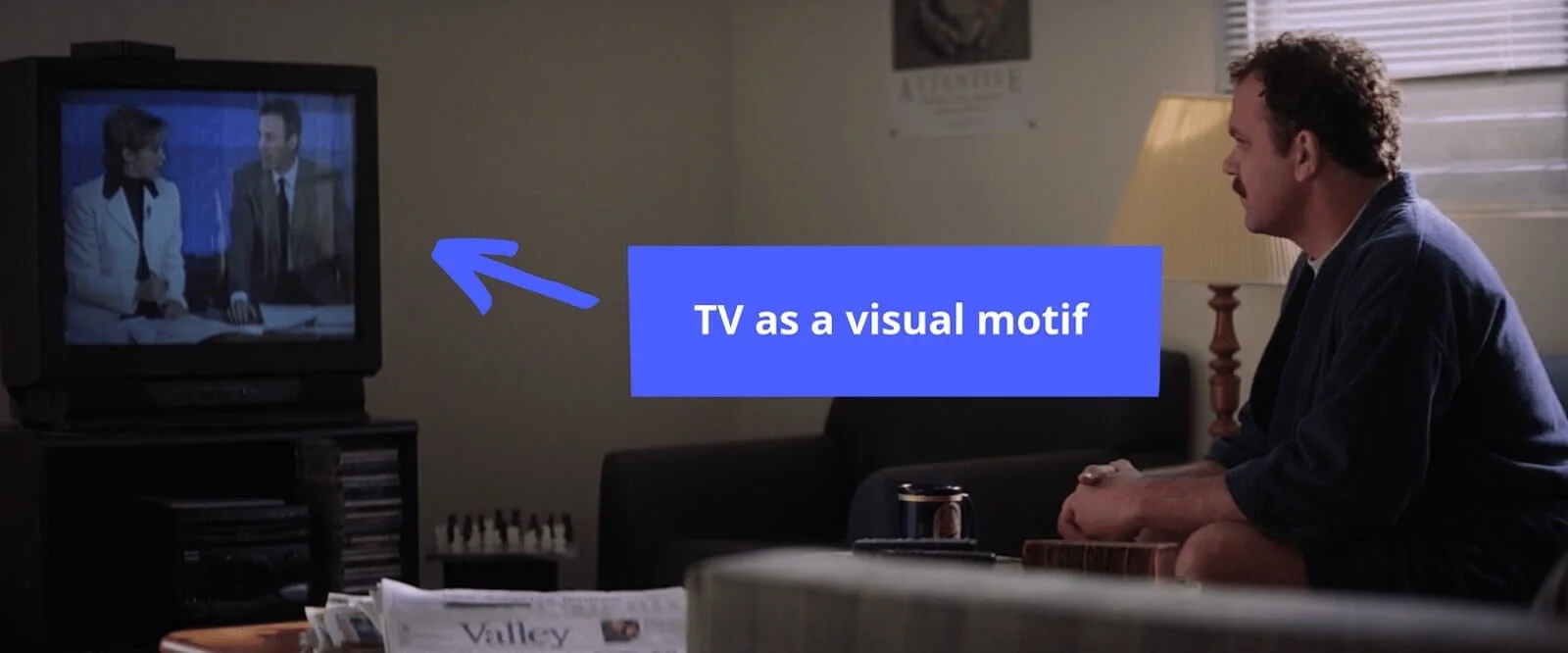
Props can connect characters
We also connect the characters with audio. Like most montages, a song plays on the soundtrack and the sequence resembles a music video. In this sequence, we have Aimee Mann's cover of "One Is The Loneliest Number."
But Anderson also uses diegetic audio to transition between the different characters. Diegetic sound is anything coming from the actual scene (e.g., when a character listens to music on the radio).
In this montage, we use the audio from TV programs to carry over. We watch Frank T.J. Mackey's (Tom Cruise) infomercial until we cut to the next character, but the sound from it continues. The next shot is Claudia (Melora Walters) at a bar, and we can assume the informercial is playing on a TV there.
When we leave Claudia, a TV in the bedroom airs a news story about Jimmy (Philip Baker Hall). We use that audio from the TV as narration as we cut to Jimmy's introduction. When we meet Stanley (Jeremy Blackman), we hear Mackey's infomercial audio again. Stanley's father (Michael Bowen) mutes the TV, but the connection has already been made.
Montages are used to communicate a lot of information efficiently. In Magnolia, we meet our main characters and understand their connection in under seven minutes. This is why Magnolia is one of Paul Thomas Anderson’s best movies.
When you plan your next montage sequence, consider how you can use techniques like these to maximize your storytelling.
4
Sound and Music
Designing Emotions
Sound Design in Punch-Drunk Love
Designing stress
Music is great for communicating and enhancing a character's emotions. But what are some other emotions that music can convey? How can sound design communicate anxiety?
In P.T. Anderson's Punch-Drunk Love, we have a fantastic example of this. Barry Egan (Adam Sandler) is a character dripping with anxiety. He is a ball of nerves. And we know this from his body language, dialogue, cinematography, and editing. But the music and sound design are how this idea is made complete.
Let's start with sound design.
We (and Barry) are continually assaulted with sound. In the first scene, Barry witnesses a car accident. The sound leading up to this moment is minimal and neutral. Suddenly, the car flips and the violent action is paired with an intense burst of sound.
Sound in Punch Drunk Love
Later, when Barry is thinking about taking the harmonium, a semi-truck comes out of nowhere. Like the earlier car crash, the truck's sound is equally assaulting.
When Barry is playing the harmonium for the first time, we see calmness and peace on his face. Of course, this is immediately shattered when Lance (Luis Guzmán) opens the warehouse door. Barry is flooded with bright light and excessively loud sound.
Semi-truck and Harmonium
Once again, our anxiety matches his. Through this sound design, we begin to understand what it must be like to be Barry Egan.
Music in Punch-Drunk Love
Soundtracking anxiety
Some of the music is crafted to mimic anxiety as well. Early in the film is a sequence that has all the tension of a high-speed car chase. But it's happening in Barry's head, and it comes through the music.
In the sequence, Barry is having a very hectic day. He's meeting with clients, and his sisters take turns calling and pestering him about attending a party that night. And earlier in the day he met a beautiful woman who he expects to show up again any minute.
Jon Brion's score during this sequence is a collage of chaos. What we hear is random, sharp, atonal, abstract, and far from recognizable music.

“To make a film, the final big collaborator you have is the composer.”
— Paul Thomas Anderson
It's a freeform mix of clicking, scratching, drumming, and other odd instruments. According to Brion, there are also sounds of duct tape peeling off the roll. It sounds as if someone recorded a bunch of toddlers in a music store as they fumble around with the instruments.
This is the sound of Barry's anxiety
Here's a challenge: in your next project, think of a character experiencing a specific emotion. Choose something nuanced like paranoia. Now imagine what music would best serve the scene.
What do you hear?
5
Production Design
Costumes and Confines
Costumes in Inherent Vice
Presenting character
When you meet someone, you form your first opinion of them within seconds. Most of that impression comes from their physical appearance. It's not judgmental; it's human behavior.
Short, tall, fat, skinny. Well-dressed, under-dressed, long hair, short hair. Beard, mustache, earrings, necklace. When you're designing the look of your characters, all these elements should be considered.
In a perfect scenario, the audience will pay attention to the costumes on a superficial level. But subconsciously, the overall effect of the character's wardrobe plays a part in our experience.
Inherent Vice has some great examples of costuming that informs the character. Like many of Anderson's films, it is a period piece. Specifically, it is set in Southern California in 1970.
Many demographics come together in the film. There are beach bum hippies and the straight-laced cops. There's a white-robed cult, a biker gang, and a member of the Black Panther party. Each group has a distinct and meaningful outer appearance.
Let's look more closely at our lead character, Doc Sportello, and Det. Bjornsen. Doc is a private investigator, and Bjornsen is LAPD. We understand very quickly that these two men have a love-hate relationship.
Idealistically, they are two sides of the same coin. They clash on many topics, even if their ultimate goal is the same. Doc is a dirty hippie, and Bjornsen is a man of the law.
Larry “Doc” Sportello
Doc has unruly hair, mutton chop sideburns, and he is either barefoot or wearing sandals at all times. His approach to solving the case is loose and sometimes unfocused. His costume echoes this.
Bjornsen appearance is a bit different
Bjornsen is uptight and frustrated. He sports a buzzcut, no facial hair and often wears a black suit and tie. Bjornsen is a no-nonsense detective. He's the opposite of Doc in every way. This dichotomy is made clear in something we take for granted: costumes.
In your next film, don't forget about what your characters should wear. Thoughtful costume design is strong filmmaking. It will speak volumes to the audience, and it will enhance the actor's performance.
Locations in Phantom Thread
Confine your characters
If you've seen Phantom Thread, you know it's an intimate story. Actually, strike that — it's a claustrophobic story. Reynolds Woodcock (Daniel Day-Lewis) is a premiere dressmaker. He is demanding of others and himself.
His home is also where he and his many seamstresses work. The building is an elegant, Georgian townhouse. It is a tall building, but it is not wide. The 5-story home is much more vertical than horizontal.
This is not a set that Anderson built on a soundstage. It is an actual location where he shot a majority of the film. Why did Anderson shoot in this building? What was it about the cramped architecture that appealed to him?
He chose it to add to the tension his story called for. Woodcock's personality is quiet but intimidating. If he lived in a mansion, this would not come across. His soft-spoken militancy would be an empty threat.
The drama is elevated because these characters have no escape. They live on top of each other, and this pushes them past intimacy. Look at this breakfast scene and notice how the lack of physical space is stifling.
An uncomfortable breakfast
Three characters are sitting at a table, which takes up a majority of the space. Even the table is crowded with dishes, food, and teapots. The wall curves around their backs, surrounding them.
This is a tight, uncomfortable space. The dialogue in the scene is also awkward. Now, imagine the same scene in a large dining room. It would not have this effect. We might see the literal and feel the emotional distance between the characters...but the tension would be gone.
When searching for the perfect location for your scene, consider how the space (or lack of space) will add to it. It's not easy to shoot in such tight quarters, but the effect it has on the actors will enhance their performance. This is why your production designer should be aware of the space ahead of time, or even collaborate with the location manager to create the best space for the story.
script breakdown
There Will Be Blood breakdown
Writing a screenplay is very different from writing a novel, for example. Screenwriting is usually limited in scope and the filmmakers "fill in the gaps." It is the director’s job to visualize the script and put their personal stamp on it. P.T. Anderson does this every time out, which makes him an auteur director.
In a novel, you can spend pages describing a location. The reader gets the details from your words and their imagination. In a screenplay, you don't have that luxury. You have to limit your descriptions to what is necessary and move on.
This where a script breakdown becomes essential. This is how you can gather your ideas for the look of a scene, or discuss details about the necessary props.
In the script breakdown process, you have an opportunity to refine your vision and work out the details. We've taken the spectacular final scene from There Will Be Blood as an example of how it works. The dialogue and performances are great but what details were added to make the scene so memorable?
The script is very light on details. The dialogue is the primary focus of the scene. There isn't much specificity about the look of the location, the costumes, etc.
In this scene, Daniel Plainview (Daniel Day-Lewis) is all washed up. His decades of ruthlessness have made him rich but alienated everyone around him. He is alone, alcoholic and unhinged.
Outside of the dialogue, what decisions must be made to turn this scene from words on a page to moving images? One of the few descriptions we get from the script says, "There are empty liquor bottles around...signs of a MESS/BOOZE/TROUBLE."
We get a very basic idea of what the scene should look like. And this is where a script breakdown comes in. Watch the scene here:
I Drink Your Milkshake
Let's start with costume, make-up, and hair. These elements of filmmaking might be taken for granted, but they are crucial. So much of a character's performance is informed by their presentation.
There is no denying Daniel Day-Lewis' award-winning performance. It just might be the best acting ever committed to film.
But when we examine Plainview's outer layer, we see his hair is unwashed, and his stubble is overgrown. His boots have holes worn in them. His sweater is stained and looks like it hasn't been washed in far too long.
In contrast, Eli Sunday (Paul Dano) is clean shaven, his hair is slicked back, and he is impeccably dressed. He is put together in every way that Plainview is not.
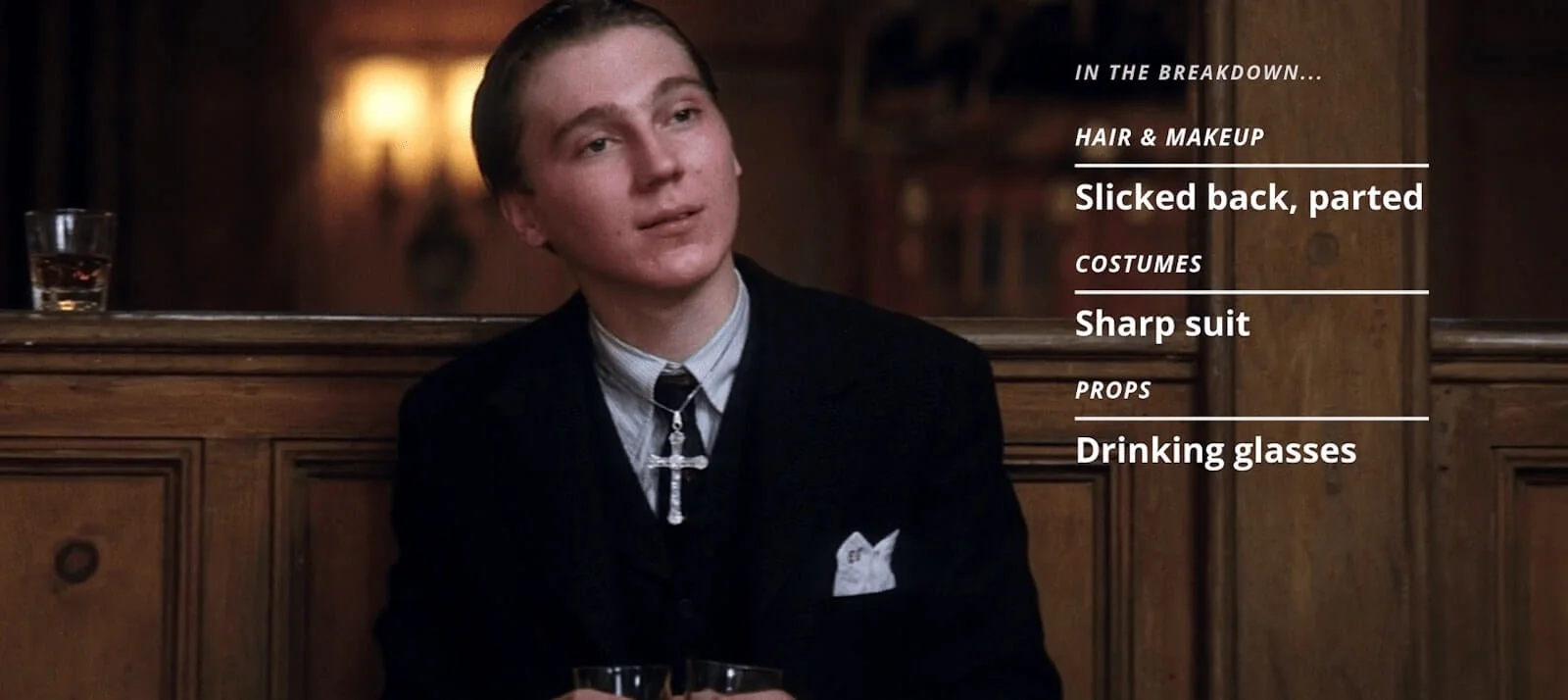
Eli, trying his best
Before they even speak, we can tell a lot about their situations.
This scene also calls for specific props. Plainview's is eating and drinking in the scene. But he's not drinking from a glass, and he's not eating with utensils.
Plainview chugs alcohol straight from a large, glass jug. And he is eating what looks like a steak, cooked days earlier. You might think a question like, "What should the steak that Daniel eats look like?" is a waste of time.
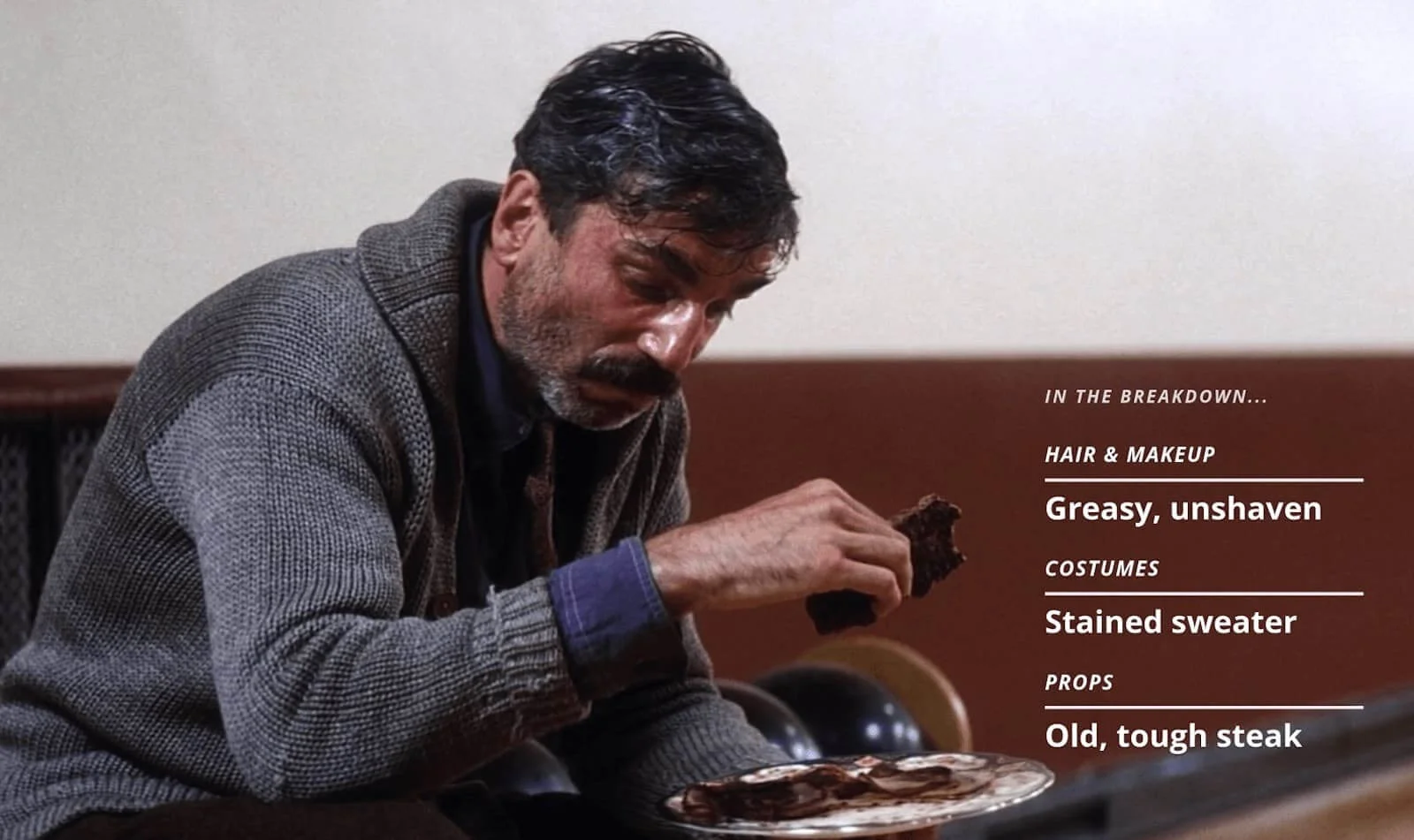
Props Affect Performance
But watch the scene again. Notice how the toughness of the steak makes his consumption of it more primal and raw. Notice how he has to remove bones or pieces of fat from his mouth. This scene would not be the same without that overcooked and tough steak.
These are considerations that can be made at the script level in a breakdown. When you break down your script, you can be as detailed as you want. And your film will be better off because of it.
Auteur Theory Made Practical
Explore directing techniques used by the greats
Create works like these iconic auteur directors. Explore practical directing tips you can immediately put into action on your next project
EXPLORE Auteur Directors
6
PTA's Music Videos
More Than Movies
Extracurricular Activities
From Fiona Apple to Radiohead
Music has always been a big part of Paul Thomas Anderson movies. His relationship with music is seen and felt in all his feature films. But he’s also spent a lot of time during his career making short form music videos as well.
He’s worked multiple times with Fiona Apple, Joanna Newsom, Radiohead, and Haim. What’s interesting is the lack of any obvious stylistic connections between a PTA movie and his music videos. Why might that be? Give us your thoughts in the comments.
Without further ado, here are some highlights from his music video output.
Aimee Mann: Save Me
And of course, Fiona Apple's iconic Beatles cover.
Across the Universe
And another one...
Paper Bag video
Maybe he's a fan?
PTA Music Videos: Fiona Apple's "Hot Knife"
Anderson stays busy even directing newer artists' videos.
Watch here
Not just one, but two...
Haim's "Valentine"
PTA directs videos from some iconic musicians....
Radiohead The Numbers
Yes, more Radiohead!
Daydreaming music video
The visuals in the next music video are indicative of PTA's style.
PTA Music Video: Divers
Up Next
PT Anderson movies, ranked
Now that we've emerged from our deep dive into Paul Thomas Anderson's directing style, let's look at the films themselves. What's your favorite PT Anderson film? When dealing with such powerhouse movies like The Master, There Will Be Blood and Magnolia, it was actually quite tough to choose our favorites.
Up Next: PTA's best movies →
Showcase your vision with elegant shot lists and storyboards.
Create robust and customizable shot lists. Upload images to make storyboards and slideshows.

